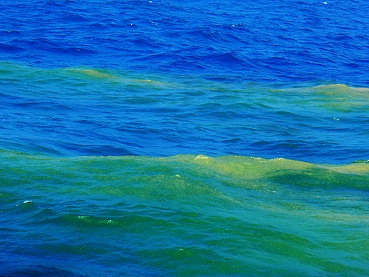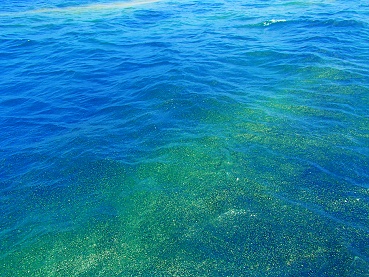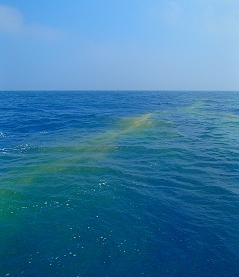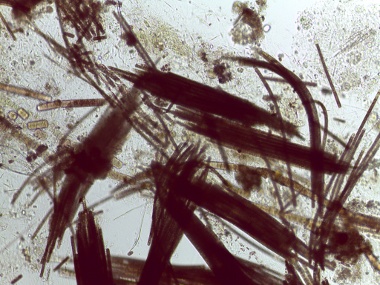


Figure 1: These surface slicks of Trichodesmium erythraeum were observed from the deck of the R/V Alis during the SPOT-8 cruise.
Photographs courtesy of Cécile DupouyThe southwestern tropical Pacific is known for its extensive Trichodesmium blooms — indicated in old marine charts as "discolored waters" or "sea dust". Such Trichodesmium accumulations appear every year between November and March and their discolored waters extend as orange and yellow bands at the surface as soon as winds calm.
From the 14th to the 16th of December 2014, slicks of Trichodesmium were observed continuously en route to the South Pacific Ocean Time Series (SPOT) station during the SPOT-8 oceanographic cruise aboard the R/V Alis (Figure 1). Nets were used to collect surface slicks on the 15th of December 2014. Microscopic observations of the net samples (Figure 2) confirmed that they were 100% composed of healthy colonies of Trichodesmium erythraeum. Slicks were also characterized by high phycoerythrin concentrations at depths of 0 to 50 meters with a maximum value at 5 meters.
The 19th December 2014 MODIS and LANDSAT 8 images (Figure 3) perfectly captured the intensity of the bloom and numerous elongated patches formed by wind-driven Langmuir cells.
Cécile Dupouy (MIO), Martine Rodier (EIO) and Isabelle Biegala (MIO)


Figure 1: These surface slicks of Trichodesmium erythraeum were observed from the deck of the R/V Alis during the SPOT-8 cruise.
Photographs courtesy of Cécile Dupouy
Figure 2: This micrograph shows colonies of the cyanobacterium, Trichodesmium erythraeum, collected during the SPOT-8 cruise.
Micrograph courtesy of Cécile Dupouy
Figure 3: In the morning of December 19th, 2014, Landsat 8 orbited over Melanesia and collected imagery (insets) of Trichodesmium blooms between New Caledonia and Vanuatu. Four hours later, the Aqua satellite passed over the same region allowing its MODIS instrument to capture an afternoon image (background) of the same blooms.
Separate full-resolution versions of the Aqua/MODIS image and the Landsat 8/OLI images are also available.